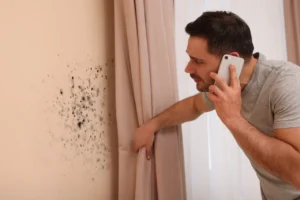How to Clean and Maintain Your Wood-Burning Fireplace
 Keep your fireplace in peak condition with regular cleaning and inspections. These fireplace maintenance tips will help prevent dangerous buildup and keep your home safe and clean in colder weather.
Keep your fireplace in peak condition with regular cleaning and inspections. These fireplace maintenance tips will help prevent dangerous buildup and keep your home safe and clean in colder weather.
A warm, crackling fire is a huge comfort in chilly months, but burning real wood creates quite the mess in your fireplace. With every fire, ash, soot, creosote, and other debris collect inside your fireplace, and over time, this buildup can pose a dangerous fire hazard. Neglecting regular fireplace cleaning can also result in dark stains around the hearth and mantel or cause fine ash and dust to spread throughout your home’s air. Follow our instructions on how to clean a fireplace to clear away harmful buildup and ensure you’re ready for cozy nights around the fire. We’ll also walk you through how to inspect a fireplace for damage, tips for removing creosote buildup, and what to know about cleaning a chimney. A bit of fireplace maintenance can help keep your home safe and tidy all season long.
How to Clean a Fireplace
If you use your wood-burning fireplace frequently, plan to clean it about once a week. For occasional use, a monthly or bi-monthly fireplace cleaning will likely suffice. Deep-cleaning can be done annually or as you notice stains and buildup.
What You Need
- Dropcloths or plastic sheeting
- Dust mask
- Safety goggles
- Rubber gloves
- Small trash can or bucket
- Fireplace shovel
- Hand broom and dustpan
- Vacuum with hose attachment or shop vacuum
- Trisodium phosphate (TSP)
- Bleach
- Warm water
- Bucket
- Spray bottle
- Stiff-bristled brush
- Paper towels
- Fireplace glass cleaner (optional)
- Dish soap
Step 1: Protect the surrounding area.
Wait 24 hours after your last fire before cleaning a fireplace to ensure it’s completely cool. This task will likely get messy, so plan to wear old clothing, and take precautions to avoid inhaling soot and ash. Wear safety goggles, gloves, and a dust mask or respirator. Cover surrounding furniture and surfaces with dropcloths or plastic sheeting.
Step 2: Remove ash and debris.
Discard any remaining chunks of burnt wood. Remove the andirons and grate and set aside. Using a fireplace shovel ($15, Walmart), scoop out ash and debris into a small, lined trash can or bucket. Alternatively, use a handheld broom to sweep ash from the walls and floor of the fireplace into a dustpan and discard. Remove the remaining dust on the walls and floor with a shop vacuum or the hose attachment of your regular vacuum.
Step 3: Deep-clean the firebox and surround.
Use a solution of trisodium phosphate (TSP), bleach, and warm water to deep-clean your fireplace. Wearing rubber gloves, mix 6 Tbsp. of TSP, 1 cup of bleach, and 1 gallon of warm water in a large bucket. Pour some of the cleaning solution into a spray bottle, and saturate the walls and floor of your firebox, as well as any stained areas of the hearth or surround. Let sit for five minutes. Dip a stiff-bristled brush into the remaining mixture and scrub the walls and floor of your fireplace until clean. Rinse with clean water and let dry.
Step 4: Clean the fireplace doors.
Leftover ash can serve as a mild, natural abrasive for cleaning fireplace doors. Dip a damp paper towel into your bucket of ash and scrub the doors until clean. Wipe away any remaining residue with clean paper towels. Alternatively, clean the doors with a fireplace glass cleaning product ($20, The Home Depot) following the manufacturer’s instructions.
Step 5: Clean the andirons and grates.
Wash the andirons, grates, and other fireplace tools with dish soap and water. To avoid making a mess indoors, consider cleaning fireplace accessories outside. Use a stiff-bristled brush to scrub any stubborn stains. Rinse and let dry before replacing the andirons and grates inside the fireplace.
Wood-Burning Fireplace Maintenance
In addition to regular cleaning, fireplaces and chimneys should be inspected for damage or buildup annually, according to the National Fire Protection Association. Although inspecting a fireplace isn’t a particularly difficult job, it is a dirty one. Wear old clothes (including a hat). Put on a dust mask or respirator and safety goggles.
First, check the firebox for cracks and loosening joints. In a masonry fireplace, you should also check for damage to bricks and mortar. Make minor repairs to firebox joints and cracks using refractory cement; it’s designed to handle the extreme heat conditions in a fireplace and it’s readily available at fireplace stores.
Next, open the damper completely. It should move freely and sit snugly against the throat. Make sure the metal is solid with no cracks, severe pitting, or rusted-through sections. Replacing a damper is not a do-it-yourself job; if the damper is in bad shape, hire a professional to replace it.
Using a high-powered flashlight or work light, look up the flue to check for damage. Metal flue liners should be clean and the joints well aligned. Tile or masonry flue liners should be solid and free of cracks. All repairs should be done by a certified professional.
You should also make sure the chimney is unobstructed by leaves and other debris that have fallen into the chimney. Chimneys are also favorite nesting places for birds and squirrels, even if it’s only been a few months since the fireplace was last used. If you can’t see the entire flue from below, you’ll have to check from the roof. If you’re at all uncomfortable doing this or have no experience working on a roof, hire a professional chimney sweep to inspect and clean the chimney.
If you prefer to leave the messy job of inspecting and cleaning your fireplace or stove to someone else, expect to pay $100-$200 for a professional inspection and cleaning. Some sweeps use tiny video cameras and lights to get an up-close look at every inch of a flue and establish a visual record of the chimney’s condition for the homeowner. Although the chimney sweep industry is not regulated or licensed by a government agency, many sweeps apply for certification by the Chimney Safety Institute of America (CSIA) or membership in the National Chimney Sweep Guild (NCSG). These organizations promote professionalism in the industry by testing applicants and providing continuing education opportunities to keep members up-to-date on current technology and fire safety.
How to Remove Creosote Buildup
When wood burns, it produces water vapor, gases, and smoke. Ideally, all these are swept up the flue and out the chimney. However, as these warm vapors reach the upper parts of the chimney, they encounter the cooler outdoor air and condense, forming creosote. This black or brown residue clings to the inner surfaces of the flue liner and can be hard and glassy, sticky, or even dry and flaky.
When enough creosote builds up in a flue, it can catch fire. Although new flue liners must be rated to withstand 1,700-degree temperatures, a flue fire can reach 2,500 degrees. Should a flue fail in a fire, the nearby wood framing members and insulation in a house can ignite. Plus, flue fires can be insidious events. A small hot spot can smolder for hours after the fire in the firebox has been safely extinguished. Hidden in the chimney, a fire can build and spread throughout the flue undetected.
In addition to removing soot and other debris from a flue, be sure all creosote is removed every time the fireplace is cleaned. Remember that chimney sweeps see a lot of fireplaces and flues, so their eyes are better trained to recognize the difference between creosote buildup and plain soot. Having your chimney professionally cleaned is often the best way to remove creosote, but you can also burn a creosote sweeping log ($15, The Home Depot) or use another type of creosote remover, following the manufacturer’s instructions, to eliminate some of the buildup yourself.
How to Clean a Chimney
Use common sense to decide if you want to clean a chimney yourself. Working on a roof is inherently dangerous, so take every precaution to protect yourself and ensure safety. The cost of hiring a good chimney sweep is usually modest, and these professionals have all the right equipment for the job. Regardless, it’s helpful to know what chimney cleaning entails to ensure the work done on your home is thorough.
If you choose to clean the chimney yourself, start by getting the right brushes. Chimney-cleaning brushes ($23, The Home Depot) are large with stiff wire or plastic bristles. The handle of this type of brush is threaded so you can attach a series of flexible, fiberglass rods that allow the brush to reach and clean the full length of the flue.
Inside the house, lay dropcloths around the hearth area and close the glass doors. Have a heavy-duty shop vacuum ready to remove the debris loosened by the cleaning. Start at the chimney opening, brushing the entire surface of the flue within reach. Then add a length of rod to reach further and continue cleaning. Finish cleaning in the firebox and use the shop vacuum to clean up; be sure to also vacuum the damper area and smoke shelf.
Source: Better Homes & Gardens













 Accessibility
Accessibility